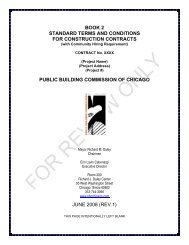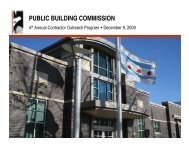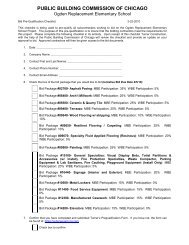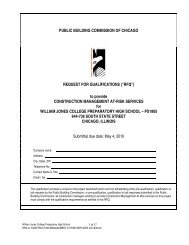Water Reuse Handbook - the Public Building Commission of Chicago
Water Reuse Handbook - the Public Building Commission of Chicago
Water Reuse Handbook - the Public Building Commission of Chicago
You also want an ePaper? Increase the reach of your titles
YUMPU automatically turns print PDFs into web optimized ePapers that Google loves.
<strong>Water</strong> <strong>Reuse</strong> <strong>Handbook</strong><br />
Tools and Strategies: Greywater System Design<br />
Greywater System Design<br />
Introduction<br />
22 : <strong>Public</strong> <strong>Building</strong> <strong>Commission</strong> <strong>of</strong> <strong>Chicago</strong><br />
Greywater systems, although quickly growing in popularity around<br />
<strong>the</strong> world, have been slower to catch on in <strong>the</strong> <strong>Chicago</strong>land area.<br />
This is likely due to <strong>the</strong> fact that this area gets adequate rainfall<br />
for irrigation and even for toilet flushing, if desired, and greywater<br />
systems are more complex and expensive than rainwater harvesting<br />
systems. However, as water conservation pressures increase<br />
internationally, and interest in environmental and water stewardship<br />
rises, greywater may become a more widespread and viable option in<br />
<strong>the</strong> <strong>Chicago</strong>land area.<br />
The basic strategy <strong>of</strong> a greywater system for interior building reuse<br />
is to harvest greywater from appropriate sources (such as shower,<br />
lavatory, and laundry water), filter and purify <strong>the</strong> water to an<br />
acceptable water quality standard, and store it until needed to flush<br />
toilets and/or urinals. Greywater reuse makes <strong>the</strong> most sense where<br />
an adequate source water is present and available to be harvested.<br />
For example, a public restroom with only includes a few sinks and<br />
toilet/urinal fixtures and is likely not worth <strong>the</strong> expense <strong>of</strong> installing<br />
a greywater system when a rainwater harvesting system would be a<br />
better choice. <strong>Building</strong>s that incorporate showers, such as fire stations<br />
or residential buildings, are good candidates for greywater systems<br />
as <strong>the</strong> water from one shower is approximately equal to one person’s<br />
flushing needs for a day. See Planning for a Greywater System for<br />
more information on choosing <strong>the</strong> proper system.<br />
This section provides a series <strong>of</strong> recommendations for <strong>the</strong> components<br />
believed to be needed for a greywater system to protect public safety.<br />
The components included in <strong>the</strong> diagram on <strong>the</strong> previous page,<br />
Sample Greywater System Diagram, are explained in greater detail<br />
and more options for system components are given in <strong>the</strong> narrative<br />
that follows.<br />
Following <strong>the</strong> recommendations <strong>of</strong> this section does not guarantee<br />
system permitting or approval from <strong>the</strong> City <strong>of</strong> <strong>Chicago</strong> or State <strong>of</strong><br />
Illinois. Ra<strong>the</strong>r, <strong>the</strong>se design guidelines are meant to be used as a<br />
starting point for <strong>the</strong> creation <strong>of</strong> a greywater system specific to <strong>the</strong><br />
project at hand.<br />
System Design<br />
City/State Review<br />
& Approval<br />
System<br />
Installation<br />
City/State<br />
Inspection &<br />
Approval<br />
Testing &<br />
Reporting<br />
August 2011
















